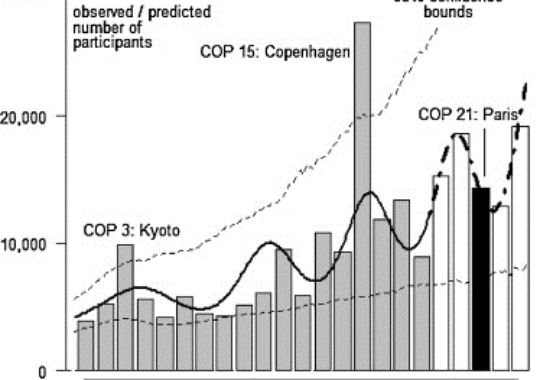By Elizabeth Plascencia

A match was lit at COP17 in Durban, South Africa. The supplementary body known as the Ad Hoc Working Group on the Durban Platform for Enhanced Action (ADP) was established that December. The inclusive nature of this platform is proposed to ignite change at COP21 in Paris. The mandate of the ADP calls to “…develop a protocol, another legal instrument or an agreed outcome with legal force under the Convention applicable to all Parties, which is to be completed no later than 2015 in order for it to be adopted at the twenty-first session of the Conference of the Parties (COP) and for it to come into effect and be implemented by 2020” (UNFCCC, 2014). “Bottom-up” and “top-down” are two predominant approaches to climate change policy within the two decades of the work under the Convention. This seemingly urgent call of action as per the ADP requires a symbiotic relationship between the two. A “mixed-track” approach is better suited to achieving the post-2020 goals of the Ad Hoc Working Group on the Durban Platform on Enhanced Action under the balanced dimensions of stringency, compliance, and participation for all Parties.
The international climate regime exhibits both approaches working well independently to a certain extent. Therefore it is proposed that a combination of the two will facilitate a more efficient and effective global combat on climate change by 2020. Within the article The Durban Platform: Issues and Options for a 2015 Agreement, Bodansky clarifies the range of confounding variables to international agreements, historic context relating to the Convention, and options to possible Durban outcomes. I initially gravitated towards the “bottom-up” approach as better suited on the basis of personal optimism regarding local grass-roots movements and voluntary national programs. Upon reading the article I soon realized that there are hard to ignore pros to the “top-down” method and that solely voluntary programs do little when brought in a global context. I found that the policy informs and enforces to a further extent in which “International law can serve a number of catalytic and facilitative functions. Gathering such as the annual meeting of the UNFCCC Conference of the Parties can focus attention, help raise public concern, and prod states to do more” (Bodansky, 2012). Legal agreements, legislation, and recommendations remain crucial in terms of maintaining stringency. However, it is important to be mindful of all Parties’ capacity in order to balance compliance and participation.
Working towards the cooperation of 195 countries with distinct agendas and interests may seem like a nearly impossible task but in order to achieve equitable, efficient, and effective international policy a new approach must be considered. A “mixed-track” combining both “top-down” and “bottom-up” approaches is better suited to achieving the post-2020 goals of the Ad Hoc Working Group on the Durban Platform on Enhanced Action under the balanced dimensions of stringency, compliance, and participation for all Parties.
***Check out this article about projections for COP21 in Paris next year: http://www.usatoday.com/story/tech/columnist/vergano/2013/05/11/climate-paris/2149167/
Works Cited
Bodansky, Daniel. “The Durban Platform: Issues and Options for a 2015 Agreement” Center for Climate and Energy Solutions. 2012
UNFCCC – Ad Hoc Working Group on the Durban Platform for Enhanced Action. “What is ADP?” http://unfccc.int/bodies/body/6645.php. 2014
UNFCCC – Draft Decision “Establishment of an Ad Hoc Working Group on the Durban Platform for Enhanced Action” https://unfccc.int/files/meetings/durban_nov_2011/decisions/application/pdf/cop17_durbanplatform.pdf. 2014
